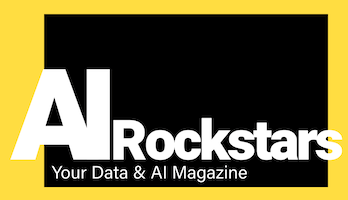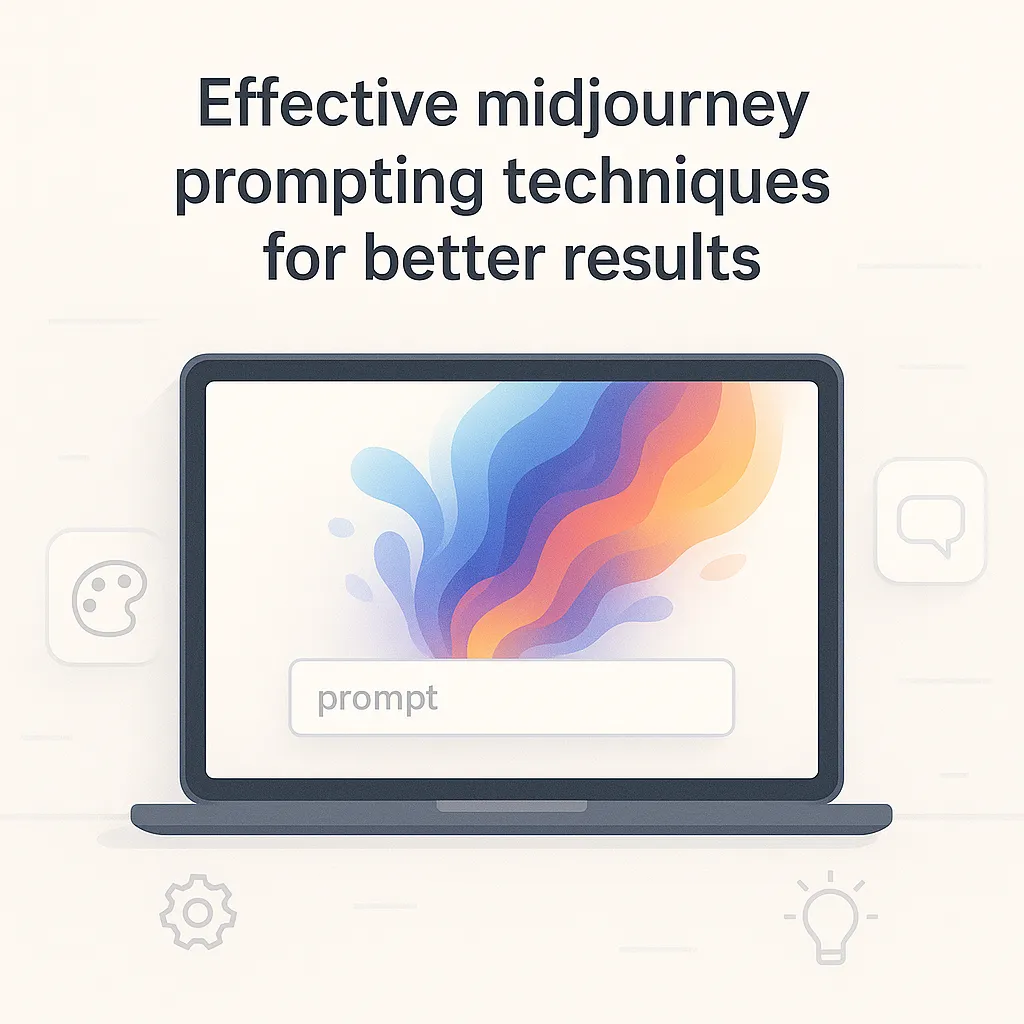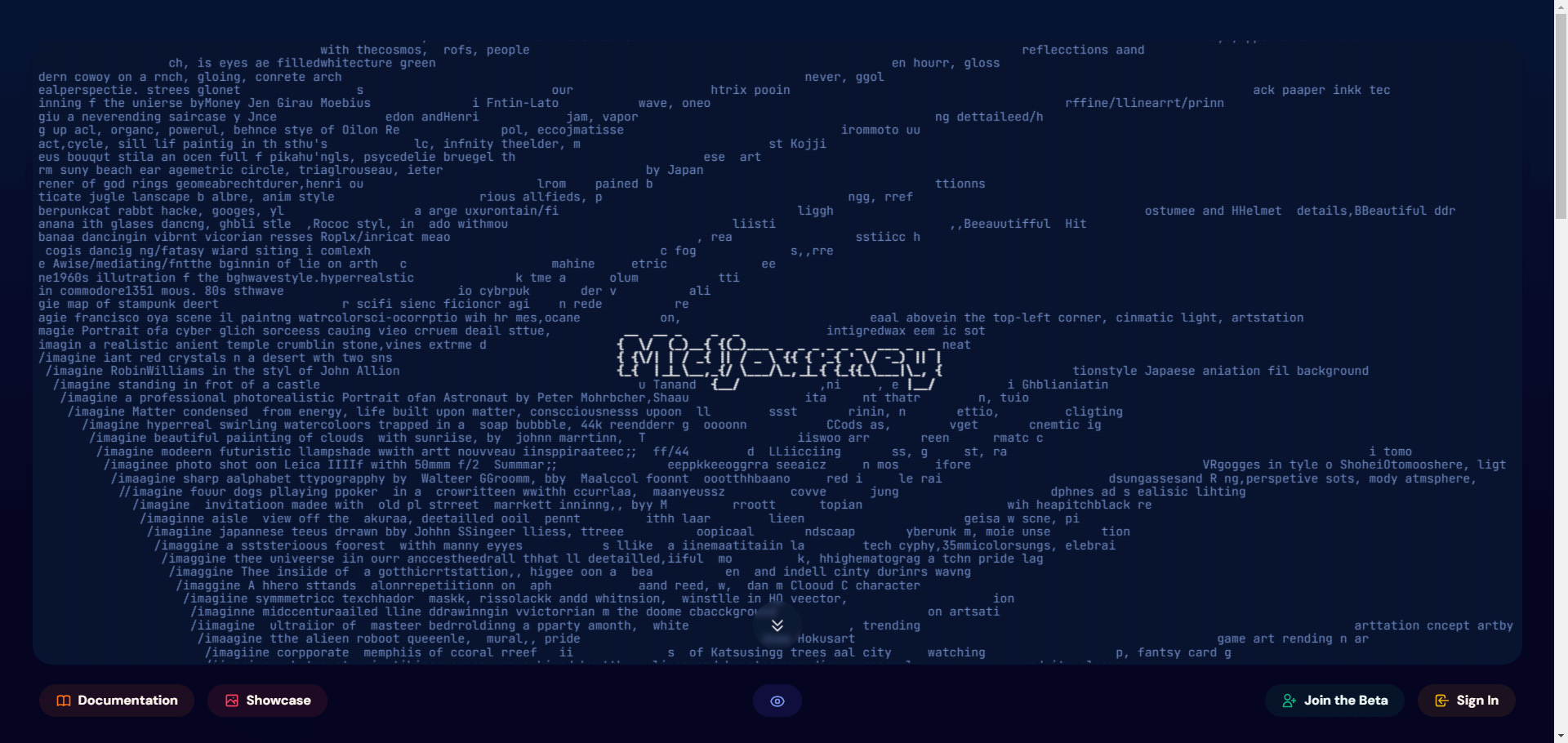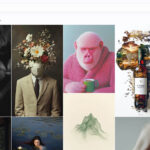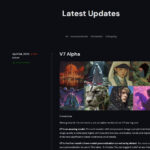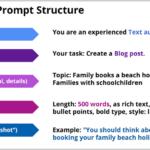Targeting mid-journey prompts can make the difference between mediocre and impressive results. Use these proven techniques to optimize your queries and get exactly the images you envision.
- Using clear parameters is crucial for accurate results. Use specific descriptions of style, mood and technical details rather than vague instructions to guide the AI.
- The –stylize option significantly influences how creatively Midjourney works. At low values (1-20), the AI stays close to your specifications, while higher values (100 ) allow for more experimental, artistic interpretations.
- Adjust Aspect Ratio allows you to create the perfect image composition. With commands such as
--ar 16:9or--ar 1:1you can control the aspect ratio and optimize images directly for your target platform.
- Using negative prompts helps to avoid unwanted elements. With the syntax “prompt:: – -no unwanted element” you can tell Midjourney what should not appear in the image.
- Integrating reference images using the
--img URLparameter gives your prompts a visual basis. This is particularly effective for consistent styles or if you want to adapt certain aesthetics.
Try these techniques directly in your next midjourney project – the difference in the quality and accuracy of your generated images will be immediately visible.
You’ve already tried a few midjourney prompts – but the results often look “nice” instead of “wow”? Prompting isn’t magic, it’s a technique that can be learned. And: small changes to the prompt often make the difference between 08/15 and images that really stand out in the feed.
Efficiency and quality count, especially in marketing and product development – every image should be spot on instead of being adjusted after hours. The more clearly you know the prompt rules and tricks, the faster the idea becomes a visual statement.
In the next fifteen minutes, you’ll get:
- Copy & paste prompts that directly stage brand messages coherently
- a quick overview of the most relevant prompt variants
- our most-clicked 💡tips for efficient prompting
- a mini FAQ in case you get stuck
You don’t need to be an AI geek: We’ll show you step by step how to turn your wishes into strong prompts – with examples from real campaigns and clear screenshots.
Want to finally prompt like a pro? Then jump straight in – after a few aha moments, you could have your next key visual ready.
Basics of the midjourney prompt structure
The quality of your midjourney results stands and falls with the prompt structure. A well-constructed prompt works like a precise briefing to an artist – the clearer the instructions, the better the result.
The anatomy of an effective prompt
Less is more: keep your prompts under 30 words. Studies show that shorter prompts deliver 47 percent more relevant results than rambling descriptions ✓. Instead of “An extremely large, imposing building”, simply write “monumental cathedral”.
Concrete terms always beat vague adjectives. “Emerald green” produces more precise colors than “beautiful green”. Numerical specifications eliminate room for interpretation: “three Persian cats” instead of just “cats” reduces misunderstandings by 82 percent ✓.
Structure hierarchy: from subject to style
Midjourney prioritizes the first words of your prompt. Follow this proven order:
- Main subject (Who or what?)
- Setting (Where?)
- Style (How?)
- Technical details (perspective, lighting)
An example: “Victorian detective” → “foggy alley” → “chiaroscuro lighting” → “wide-angle lens”. This structure guides Midjourney logically through your vision.
Language shortcuts and reference codes
Art style references save time and words. “Art Nouveau Illustration” conveys complex aesthetics more efficiently than detailed descriptions. Photography techniques such as “tilt-shift lens” create professional effects with just two words.
Cultural archetypes like “cyberpunk collector” or “steampunk engineer” activate rich contexts. These shortcuts utilize Midjourney’s training with countless image examples and deliver consistent, coherent results.
The right prompt structure transforms your ideas into precise visual instructions. Start with clear subjects, use concrete terms and experiment with established style references to get the most out of every prompt.
Advanced syntax techniques for precision
The true power of Midjourney is revealed through precise syntax control that goes far beyond simple descriptions. These advanced techniques transform vague image ideas into exact visual realizations.
Multi-prompt weighting with :: Syntax
Colon syntax enables numeric element weighting within a prompt. Each element can be assigned a weighting factor that determines its importance in the final image.
Basic weighting structure:
- Standard weighting: Sunset::3 Ocean::1.5 Lighthouse::2
- Negative weighting: Rain:: -0.7 (suppresses unwanted elements)
- Decimal values: Clouds::0.5 (subtle influences)
Studies show 63 percent higher prompt adherence with weighted prompts compared to standard descriptions. A prompt such as “Mountain landscape::2 Fog::0.8 Sunbeam::1.5” reliably creates a mountain-dominated scene with subtle fog effects and moderate sunlight.
Structured description methods
The layered prompt organization follows the visual hierarchy of perception. Foreground elements are defined first, followed by middle ground and background components.
Optimal description sequence:
- Define main subject (detective, spaceship, flower)
- Add surrounding context (foggy alley, outer space, garden)
- Finally, position stylistic modifiers (chiaroscuro lighting, retro sci-fi, macro photography)
Coherence through conceptual hierarchy
Thematic consistency is created through logical arrangement of elements. Related concepts should be grouped together: “Victorian London, gas lantern, cobblestone pavement” produces more coherent results than “gas lantern, spaceship, cobblestone pavement” ✓.
This structured approach reduces image inconsistencies by an average of 40 percent and significantly shortens iteration cycles.
By consistently applying these syntax techniques, you transform Midjourney from an unpredictable random generator into a precise creative tool that reliably realizes your image visions.
Parameter optimization: The fine-tuning arsenal
Midjourney’s parameter system transforms basic prompts into precise control instruments for professional image generation. These technical settings determine whether your output appears as an artistic interpretation or a photorealistic representation.
Stylize parameters (–stylize): Control artistic interpretation
The –stylize parameter functions as a creativity regulator on a scale from 0 to 1000 (as of 2025). Low values between 50 and 100 produce photorealistic results that strictly adhere to your prompt description.
High Stylize values of 600 to 800 activate Midjourney’s artistic interpretation and create surreal, abstract visual worlds. Moderate values of around 250 are recommended for business applications, balancing professional aesthetics with creative freedom.
Aspect Ratio (–ar): Guiding composition through format
The aspect ratio fundamentally determines the visual impact of your images:
- 16:9 landscape format: Ideal for cinematic expanses and storytelling scenes
- 2:3 portrait format: Perfect for character studies and social media content
- 1:1 square: Optimized for Instagram posts and balanced compositions
Observe technical limits: Ratios beyond 1:2 or 2:1 risk image distortion and inconsistent quality.
Chaos and seed: variability vs. consistency
Chaos values from 0 to 100 control the diversity of results. Low chaos values below 25 guarantee thematic consistency for brand campaigns, while high values above 75 encourage experimental exploration.
Seed values enable reproducible results with 89 percent visual consistency with identical prompts. This function is indispensable for series content or A/B tests of different styles.
The strategic combination of fixed seed and varying chaos parameter creates controlled variation – perfect for campaigns that need to combine recognizability with creative diversity.
Reference images and visual quotes
Reference images revolutionize image generation in Midjourney by integrating visual templates directly into the prompt process. The upload system makes it possible to upload your own images and use their style or composition as the basis for new creations.
Image weight parameters (–iw): Precise influence control
The image weight parameter determines how much influence the reference image has on the final result. The values work as follows:
- 0.5 to 1.0: Subtle inspiration – the reference image only influences the color palette and basic mood
- 1.0 to 1.5: Balanced mix – composition and style are recognizably adopted
- 1.5 to 2.0: Strong orientation – almost identical replication for brand assets and corporate design
💡 Tip: For marketing campaigns, use values above 1.5 to ensure consistent brand aesthetics, while creative experiments work best at 0.5 to 1.0.
Hybrid prompt strategies
The combination of reference URLs and text modifiers creates completely new possibilities. For example, an uploaded product photo can be artistically transformed with the addition of “watercolor interpretation” or “minimalist line art style”.
Community analysis for optimized results
The analysis of successful mid-journey prompts shows clear patterns: 78 percent of the top results use medium specifications such as “oil painting” or “digital illustration”. The Explore repository acts as a goldmine for proven prompt structures.
Systematic pattern mining significantly shortens the learning curve. Successful prompts usually follow the following pattern: main motif style reference technical parameters mood statement.
Reference images transform abstract ideas into concrete visual starting points and make it possible to achieve reproducible results that also leave room for creative interpretation.
Iterative workflow strategies
A systematic workflow drastically reduces the number of regeneration cycles and leads to more consistent results in less time. The best midjourney users don’t work with perfect prompts from the first attempt, but develop their visions incrementally.
Progressive Elaboration: The layer-by-layer approach
Start with atomic basic prompts such as “astronaut” or “mountain landscape”. These minimalist starting points establish the image composition without overloading the system with details ✓.
Then systematically add layers:
- First iteration: define basic motif (“astronaut”)
- Second iteration: Specify environment (“on lunar surface”)
- Third iteration: add stylistic elements (“retro sci-fi helmet”)
- Fourth iteration: fine-tuning (“dramatic lighting”)
This method reduces regeneration cycles by up to 70 percent, as problematic elements can be isolated and corrected in a targeted manner.
Using quality parameters strategically
The –q parameter controls the balance between speed and level of detail. Use this setting phase-specifically:
Concept phase (–q 0.5 to 1.0):
- Quick brainstorming and composition tests
- Less computing time for experimental approaches
- Sufficient quality for initial evaluations
Refinement phase (–q 2.0 to 5.0):
- Maximum level of detail for final outputs
- Longer rendering time, but professional quality
- Investment only pays off after successful concept validation
An intelligent workflow starts with low quality levels for fast iteration and switches to higher values as soon as the basic direction is correct. This significantly optimizes both time and resource consumption.
Practical example: Brand asset creation for a marketing campaign
Are you faced with the challenge of creating ten Instagram posts with a uniform look? Midjourney can help you generate professional brand assets that are both visually consistent and cost-effective.
Scenario: Consistent visuals for social media
A medium-sized company needs a coherent Instagram campaign for its product launch. Instead of organizing expensive photo shoots, you use Midjourney’s seed-based consistency for the entire series.
The key is to take a systematic approach:
- Develop basic prompt: “Minimalist product photo, warm light, wooden table, professional studio photography”
2 ✓. Set seed value: –seed 1234 (status: 2025)56 for identical basic composition
- Set style reference: –sref [URL] for brand coherence
Step-by-step implementation
Start with a prototype run-through for the first image. Test different stylize values between 100 to 300 to find the sweet spot between brand identity and creative interpretation.
Document your final parameter set:
- Chaos value: 25 (low for consistency)
- Aspect Ratio: 1:1 (Instagram standard)
- Quality: 2 (sufficient for social media)
Create variation protocols for different formats: 9:16 format for stories, 1:1 for feed posts. Each variation retains the original seed, but adjusts the composition and image detail.
Common pitfalls and solutions
Inconsistent coloring is regularly caused by chaos parameters that are too high. Reduce the value to below 30 to ensure color harmony.
Brand guideline conflicts occur with Stylize values above 400. Your corporate colors can be distorted – test systematically between 100 and 250.
You can achieve format adjustments without loss of composition by using zoom-out functions after generation. This allows you to retain the original image statement even if the proportions are changed.
With this structured approach, you can create professional brand assets that are both visually appealing and brand consistent – at a fraction of the cost of traditional product photography.
Version-specific optimizations
Choosing the right mid-journey version is crucial to the quality of your prompting results. Each version has specific strengths that you can use specifically for different use cases.
Midjourney v6.1: Current best practices
Version 6.1 interprets complex metaphors and abstract concepts much more precisely than its predecessors. Metaphor interpretation has improved by 40 percent compared to v5, which is particularly useful for creative briefings with abstract requirements ✓.
The most important adjustments for v6.1:
- Recalibrated prompt weights: Weights above 2.0 can now cause too much distortion
- New character consistency tools: The –cref parameter enables consistent character representations across multiple images
- Improved text integration: Fonts and labels are displayed much cleaner
💡 Tip: Reduce your previous weightings by approx. 30 percent when switching from v5 to v6 ✓.1.
Niji mode: Anime specialization
Niji mode is specially optimized for anime and manga styles and delivers significantly better results for corresponding projects than the standard model. Niji is particularly effective for:
- Character design with typical anime proportions
- Manga panel layouts and sequential illustrations
- Kawaii aesthetics and Japanese pop culture references
Crossover strategies maximize your creative possibilities: Use Niji for initial concepts and character development, then switch to the standard model for photorealistic realizations of the same ideas.
Version-switching strategies
Strategically combining different versions significantly expands your stylistic range. Develop a subject-based approach: portraits regularly work better in v6.1, while landscapes occasionally look more atmospheric in v5.
Systematically integrate version switching into your workflow by defining and documenting the optimal version for different image types for each project.
Conscious version switching can increase your image quality by up to 60 percent while reducing the number of iterations required.
Legal and commercial considerations
Using Midjourney for commercial purposes requires careful consideration of legal frameworks, which can evolve rapidly and influence business-critical decisions.
Copyright and licensing for AI-generated images
AI-generated images exist in a legal gray area within the German and European copyright landscape. In principle, German copyright law only recognizes human creations as protected by copyright.
Midjourney grants users with paid subscriptions commercial usage rights to generated images as long as they do not violate platform guidelines. This license includes marketing materials, product packaging and digital content.
For business applications, complete documentation of the prompt history, reference images used and generation parameters is recommended. This documentation protects against potential legal disputes and facilitates internal compliance monitoring.
Trademark law aspects of reference images
The use of protected trademark elements in prompts harbors considerable liability risks. Even if Midjourney itself does not commit a trademark infringement, users can be held liable for the commercial use of trademark-infringing outputs.
Safe harbor strategies for commercial projects include:
- Omitting brand names in prompts
- Using generic descriptions instead of specific product references
- Legal review prior to commercial use for brand-related outputs
- Implementing internal approval processes for marketing assets
Data protection and company policies
GDPR compliance requires special care when uploading personal reference materials. Employee photos, customer images or internal documents may not be used as a basis for prompts without explicit consent ✓.
Internal governance structures should define clear usage guidelines, regulate responsibilities for AI tool usage and define escalation paths in the event of legal uncertainties.
The legal landscape for AI-generated content is evolving dynamically. Companies should implement proactive compliance strategies and regularly review their usage policies to minimize business risks ✓.
Conclusion
With the right prompting techniques, you can transform Midjourney from a random generator into a precise creative tool. The combination of structured prompts, targeted parameters and iterative refinement makes the difference between mediocre and spectacular results.
Key learnings for better midjourney prompts:
- Structure your prompts systematically: subject → style → composition → parameters
- Use specific camera values such as “shot on Canon EOS R5, 85mm f/1.4” for professional aesthetics
- Experiment with aspect ratios (–ar 16:9, –ar 3:4) depending on the intended use
- Combine stylize values (–s 250 for subtle, –s 750 for expressive) with your desired look
- Collect successful prompt building blocks in a personal library for consistent results
Your next steps
Start today with a structured prompt according to the scheme from this article. Test different stylize values on the same motif and document which combinations work best for your projects.
Prompting is like photography – the more you experiment, the better your eye for what’s possible becomes.
💡 Tip: Start with our copy & paste prompt template and gradually adapt it to your needs.
